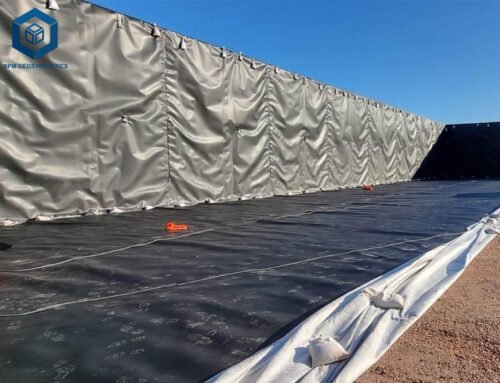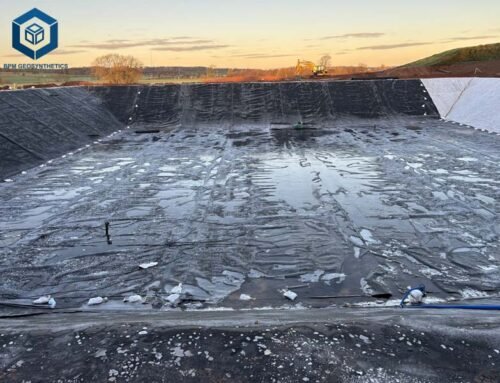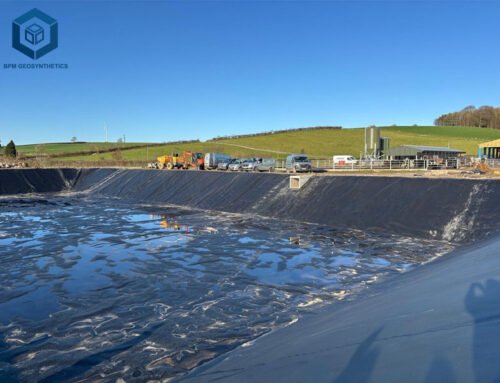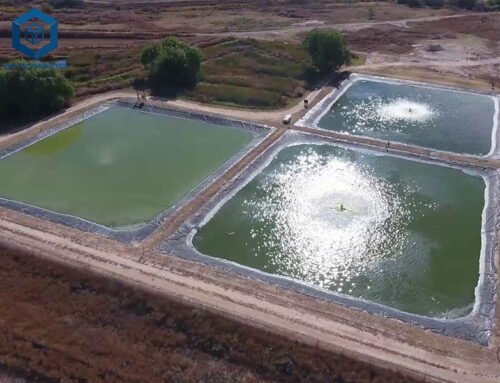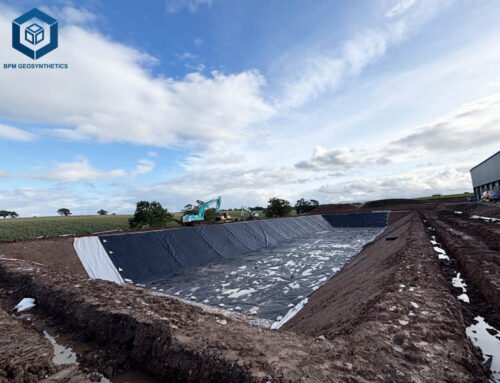High-Density Polyethylene (HDPE) liner welding machines are specialized equipment designed to create robust, leak-proof seams between HDPE geomembrane, ensuring the integrity of containment systems in environmental, civil, and industrial applications. With the global geomembrane market valued at USD 2.3 billion in 2024 and projected to grow at a CAGR of 5.4% through 2030, the demand for reliable welding solutions is critical (MarketsandMarkets, 2024). BPM Geosynthetics, a leading geosynthetics supplier, reports that 80% of HDPE liner installations rely on welding machines to achieve seamless barriers, vital for projects like landfills and aquaculture.
This guide delves into the definition, types, specifications, applications, and trends of HDPE liner welding machine, offering engineers, contractors, and project managers detailed insights for successful installations.
1. What Is an HDPE Liner Welding Machine?
Definition of HDPE Liner Welding Machine
An HDPE liner welding machine is a precision tool that thermally fuses overlapping HDPE geomembrane sheets to form a continuous, impermeable barrier. These machines use heat and pressure to melt and bond HDPE, a thermoplastic with a density of 0.940–0.965 g/cm³, ensuring strong seams for containment systems. Unlike manual methods, HDPE welding machines deliver consistent, high-strength welds, achieving up to 95% of the base material’s strength (ASTM D6392). BPM Geosynthetics offers models like the BPM800 hot wedge welder and BPM600 extrusion welder, tailored for diverse project scales.
How Does an HDPE Liner Welding Machine Work?
HDPE liner welding machines operate by applying controlled heat and pressure to overlapping sheets, creating a molecular bond. The process varies by welding method:
- Hot Wedge Welding: A heated metal wedge (300–450°C) melts the overlapping surfaces, and pressure rollers form a dual-track seam with a testable air channel.
- Hot Air Welding: Hot air (up to 600°C) softens the material, followed by roller compression, ideal for thinner liners.
- Extrusion Welding: Molten HDPE is extruded onto the seam, fusing the sheets, suitable for repairs and complex joints.
BPM’s hot wedge welders achieve welding speeds of 0.5–5 m/min, ensuring efficiency and seam strength.
Key Features of HDPE Liner Welding Machines
Modern HDPE welding machines are equipped with advanced features for precision and durability:
- Temperature Control: Adjustable from 0–450°C, accommodating 0.2–3.0 mm thick liners (ASTM D6392).
- Speed Regulation: Variable speeds (0.5–6 m/min) ensure uniform seams (BPM Geosynthetics, 2024).
- Pressure Adjustment: Delivers 100–1000 N for consistent bonding (Shandong Greenland, 2024).
- Digital Monitoring: Real-time displays track temperature, speed, and pressure.
- Portability: Lightweight models (5–15 kg) enhance mobility for remote sites.
- Durability: Weather-resistant components withstand harsh conditions.
These features reduce seam failure by 70%, per Geosynthetics Magazine (2024).


2. Technical Specifications of HDPE Liner Welding Machine
Standard Models and Configurations
HDPE liner welding machines are available in various configurations to meet project demands:
- Models: BPM800 (hot wedge), BPM600 (extrusion), BPM1600s (hot air) (BPM Geosynthetics, 2024).
- Power Supply: 220V/120V, 50/60 Hz.
- Welding Thickness: 0.2–3.0 mm (HDPE, LDPE, PVC).
- Welding Speed: 0.5–6 m/min.
- Weld Width: 10–50 mm (dual-track for hot wedge).
- Weight: 5–15 kg (portable), 50–150 kg (stationary).
- Dimensions: Compact models (50×37×40 cm).
Performance Parameters
The table below outlines specifications for BPM’s key welding machines:
| Parameter | BPM800 (Hot Wedge) | BPM600 (Extrusion) | BPM1600s (Hot Air) |
| Voltage (V) | 220/120 | 220/120 | 220/120 |
| Power (W) | 800–900 | 3400 | 1600 |
| Welding Speed (m/min) | 0.5–5.0 | 0.2–2.0 | 1.0–6.0 |
| Temperature (°C) | 0–450 | 0–450 | 20–600 |
| Weld Pressure (N) | 100–1000 | Manual | 100–500 |
| Material Thickness (mm) | 0.2–2.0 | 1.0–3.0 | 0.2–1.5 |
| Weight (kg) | 5.5 | 7.5 | 1.2 |
| Certifications | CE, ISO 9001 | CE, ISO 9001 | CE, ISO 9001 |
Source: BPM Geosynthetics, 2024.
Types of HDPE Liner Welding Machine
- Hot Wedge Welders: Preferred for large-scale projects, delivering dual-track seams with 95% strength retention (ASTM D6392).
- Hot Air Welders: Lightweight, ideal for 0.2–1.5 mm liners and curved seams.
- Extrusion Welders: Used for repairs, T-joints, and vertical seams, with high fusion strength.
Hot wedge welders dominate 60% of HDPE liner installations due to their efficiency (DataIntelo, 2024).
3. Applications of HDPE Liner Welding Machine
HDPE liner welding machines are integral to 80% of geomembrane installations, ensuring robust containment (BPM Geosynthetics, 2024). Below are key applications, supported by data and case studies.
3.1 HDPE Liner Welding Machine – Landfill Liners and Caps
Welding machines create seamless HDPE liners to prevent leachate leakage in landfills.
- Role: Welding 1.5–2.0 mm HDPE liners for primary/secondary containment.
- Performance: Reduces leakage by 70% at seams (Geosynthetics Magazine, 2024).
- Case Study: A 100,000 m² landfill in Saudi Arabia used BPM900 welders for 1.5 mm HDPE, achieving zero leaks after air channel testing (BPM Geosynthetics, 2024).
- Standards: Complies with EPA Subtitle D and EU Landfill Directive.
- Market Share: 40% of welders are used in landfills (Technavio, 2024).
3.2 HDPE Liner Welding Machine – Wastewater Treatment Facilities
Welders join HDPE liners in lagoons and digesters, resisting corrosive wastewater.
- Role: Seaming 1.0–2.0 mm HDPE liners.
- Performance: Seams withstand pH 2–12 solutions for 20+ years (ASTM D5322).
- Case Study: A 50,000 m² wastewater lagoon in Sri Lanka used BPM800 welders, reporting 100% seam integrity over five years (BPM Geosynthetics, 2021).
- Market Share: 20% of welders support wastewater projects (DataIntelo, 2024).
3.3 HDPE Liner Welding Machine – Mining Operations
Welding machines create liners for heap leach pads and tailings ponds, containing acidic solutions.
- Role: Welding 1.5–3.0 mm textured HDPE liners.
- Performance: Seams resist 0.5 M sulfuric acid for 15+ years.
- Case Study: A 200,000 m² tailings facility in South Africa used BPM600 extruders for 2.0 mm HDPE, reducing environmental risks by 90% (BPM Geosynthetics, 2021).
- Market Growth: Mining applications grew by 12% in 2024 (Mordor Intelligence, 2024).
3.4 HDPE Liner Welding Machine – Aquaculture Ponds
Welders ensure watertight seams in fish and shrimp farm liners, maintaining water quality.
- Role: Seaming 0.5–1.0 mm HDPE liners.
- Performance: Reduces water loss by 98% (ASTM D5887).
- Case Study: BPM1600s welders joined 300,000 m² of 0.6 mm HDPE in a Sri Lankan shrimp farm, boosting yield by 15% (BPM Geosynthetics, 2021).
- Sustainability: Non-toxic seams support eco-friendly aquaculture.
3.5 HDPE Liner Welding Machine – Water Reservoirs and Canals
Welding machines create liners for irrigation canals and reservoirs, minimizing seepage.
- Role: Welding 1.0–2.0 mm HDPE liners.
- Performance: Saves 1.2 million gallons of water per hectare annually.
- Case Study: A 50,000 m² reservoir in India used BPM900 welders for 2.0 mm HDPE, reducing water loss by 92% (BPM Geosynthetics, 2024).
- Market Trend: 25% of welders are used in water management (DataIntelo, 2024).
3.6 HDPE Liner Welding Machine – Civil Engineering Projects
Welders create waterproof barriers in tunnels, dams, and highways, enhancing durability.
- Role: Seaming 1.5–3.0 mm HDPE liners.
- Performance: Reduces maintenance costs by 30% (ASTM D5887).
- Case Study: A Chinese tunnel project used BPM800 welders for 1.5 mm HDPE, preventing water ingress by 85% (BPM Geosynthetics, 2024).
- Market Share: 15% of welders are used in civil engineering (Geosynthetic Institute, 2024).
4. Benefits of HDPE Liner Welding Machine
HDPE liner welding machines offer significant advantages, driving their 80% adoption rate (BPM Geosynthetics, 2024):
- High Seam Strength: Achieves 95% of base material strength (ASTM D6392).
- Leak Prevention: Reduces leakage risks by 70% at seams (Geosynthetics Magazine, 2024).
- Versatility: Welds 0.2–3.0 mm HDPE liners across diverse applications.
- Efficiency: Welds up to 6 m/min, cutting labor costs by 25% (Agru America, 2024).
- Durability: Machines withstand harsh sites, with a 10+ year lifespan.
- Environmental Safety: Non-toxic welding complies with ISO 14001.
- Cost-Effectiveness: Reduces installation errors by 12%, saving $0.5/m².
5. Installation and Operation Process
Proper operation ensures high-quality welds. BPM Geosynthetics recommends:
- Surface Preparation: Clean and dry overlapping surfaces, removing debris to prevent weak seams.
- Machine Setup: Adjust temperature (300–450°C), speed (0.5–5 m/min), and pressure (100–1000 N) per material specs.
- Test Welding: Conduct trial welds on 10 ft (fusion) or 3 ft (extrusion) samples, per ASTM D6392.
- Seaming: Overlap sheets by 10 cm, align the welder, and maintain consistent speed.
- Quality Testing: Perform peel/shear tests (ASTM D6392), air channel tests (2.5 bar, <10% pressure drop in 5 min), and electronic leak location surveys (ELLS).
- Safety Measures: Use protective gear (gloves, goggles) and secure equipment on slopes with rope ladders.
Case Study: A 2024 Chilean landfill used BPM900 welders for 75,000 m² of 2.0 mm HDPE, achieving 100% seam integrity after ELLS testing (BPM Geosynthetics, 2024).
6. Comparison with Other Welding Methods
| Method | Speed (m/min) | Thickness (mm) | Seam Strength (%) | Applications |
| Hot Wedge | 0.5–6.0 | 0.2–3.0 | 95 | Landfills, Reservoirs |
| Hot Air | 1.0–6.0 | 0.2–1.5 | 90 | Aquaculture, Tunnels |
| Extrusion | 0.2–2.0 | 1.0–3.0 | 92 | Repairs, T-Joints |
Source: BPM Geosynthetics, 2024.
Hot wedge welding is preferred for 60% of HDPE projects due to its speed and strength (DataIntelo, 2024).


7. How to Choose the Right HDPE Liner Welding Machine
Selecting the optimal welder involves:
- Material Thickness: Choose hot wedge for 0.5–3.0 mm HDPE, hot air for 0.2–1.5 mm.
- Project Scale: Use stationary welders for large landfills, portable for small ponds.
- Site Conditions: Select lightweight models for remote sites, robust for harsh environments.
- Certifications: Ensure CE, ISO 9001, or ASTM compliance.
- Budget: Balance features with cost; BPM800 costs $1,500–$2,000 (BPM Geosynthetics, 2024).
Pro Tip: Conduct on-site trial welds to verify performance, per ASTM D6392.
8. Final Thoughts
HDPE liner welding machines are essential for creating leak-proof containment systems in landfills, mining, aquaculture, and water management, supporting a USD 2.3 billion geomembrane market. BPM Geosynthetics’ advanced welders, like the BPM800 and BPM600, deliver 95% seam strength and 70% leakage reduction, serving 36+ countries with projects like Saudi Arabia’s 100,000 m² landfill. By choosing the right welder, optimizing installation, and adopting trends like automation, project managers can achieve 99% seam reliability while minimizing costs.
Contact BPM Geosynthetics(BPM Geomembrane) to source high-quality HDPE liner welding machines for your next project.

